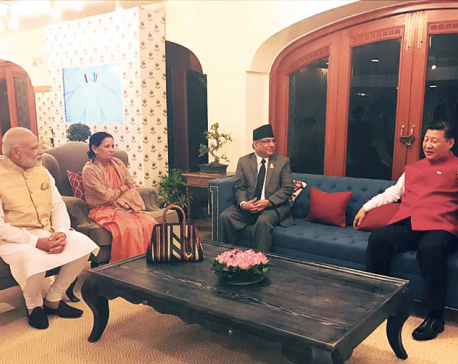
OR
#Editorial
BIMSTEC Charter in Force: Time to Fulfill Unmet Expectations
Published On: May 21, 2024 07:31 AM NPT By: Republica | @RepublicaNepal

The Charter of the Bay of Bengal Initiative for Multi-Sectoral Technical and Economic Cooperation (BIMSTEC) officially came into force on Monday, marking a significant milestone for the seven-member regional bloc with great strategic significance. The BIMSTEC region that includes countries from South Asia and South-East Asia has over 1.8 billion people, constituting 22 percent of the global population. Its combined GDP stands at USD 4.5 trillion, and its combined external trade is USD 1.95 trillion. The implementation of the BIMSTEC Charter represents a long-awaited moment for its member states, coming nearly three decades after the organization’s establishment. This also signifies their commitment to making BIMSTEC a more effective and result-oriented organization. However, the real test lies in translating this commitment into action. Despite the initial optimism surrounding BIMSTEC’s formation, its journey has been marred by slow progress and unmet expectations. Now, as the Charter takes effect, it is imperative that BIMSTEC delivers on its promises and transforms itself into a dynamic, result-oriented organization.
BIMSTEC was established on June 6, 1997, through the Bangkok Declaration with the ambitious goal of fostering regional cooperation among its member states: Bangladesh, Bhutan, India, Myanmar, Nepal, Sri Lanka, and Thailand. The initiative aimed to create an enabling environment for rapid economic development, accelerate social progress, and promote collaboration on matters of common interest in the Bay of Bengal region. Over the years, BIMSTEC has expanded its areas of cooperation to include trade and investment, technology, energy, transportation and communication, tourism, fisheries, agriculture, cultural cooperation, environment and disaster management, public health, people-to-people contact, poverty alleviation, counter-terrorism and transnational crime, and climate change. Nepal leads the People-to-People Contact sector, including culture and tourism. Despite these broad areas of focus, the tangible outcomes have been limited. The implementation of the BIMSTEC Charter, which outlines a structured framework for cooperation, provides a renewed opportunity to make meaningful progress as summits held in 2004, 2008, 2014, and 2018 failed to translate them into concrete actions despite laying out ambitious plans.
There are certain key areas where BIMSTEC must take urgent action to expedite its progress and fulfill its unmet expectations. One of the foremost areas where BIMSTEC can work to deliver is regional trade and economic integration. The BIMSTEC region's potential for intra-regional trade remains largely untapped. A Free Trade Agreement (FTA) within BIMSTEC could be a game-changer, enhancing trade volumes and economic integration. Similarly, infrastructure development is critical for enhancing regional connectivity. The BIMSTEC Master Plan for Transport Connectivity (2018-2028), supported by the Asian Development Bank, aims to improve transport linkages through significant investments in road, railway, maritime port, and airport infrastructure. Ensuring that these projects are completed with robust regulatory frameworks and addressing social and environmental concerns is essential. Agricultural trade has equally big potential to drive economic growth and ensure food security in the region. BIMSTEC must focus on policies that facilitate agricultural trade while ensuring domestic food security. BIMSTEC can learn from Thailand's experience in the Greater Mekong Subregion to promote sub-regional economic integration and ensure stable agricultural trade. Promoting clean energy transition and enhancing energy connectivity is another area where BIMSTEC can make significant strides. Bhutan and Nepal's hydropower potential presents an opportunity for exporting green energy to meet the rising demands of other member states. Establishing cross-border energy grids and infrastructure will facilitate seamless electricity transmission and promote sustainable economic growth.
The implementation of the BIMSTEC Charter marks a new chapter for the organization as it remained young even at the age of 26. It is now time for BIMSTEC to move beyond rhetoric and deliver on its promises. The challenges are significant, but so are the opportunities. With concerted effort and political will, BIMSTEC can become a cornerstone of regional cooperation and development, fostering a peaceful, prosperous, and sustainable Bay of Bengal region. Since the fate of another regional organization, SAARC, remains uncertain for now, the importance of regional and sub-regional organizations like BIMSTEC cannot be underestimated. BIMSTEC provides a conducive and effective framework for promoting cooperation among the countries in the Indian Ocean Region. Given its size of population and economy, it also makes sense for the countries in Indian Ocean Region (IOR), extra-regional countries, and regional, UN, and other international organizations, which have stakes in the region, to include BIMSTEC in the scope of their policies and programs for IOR. Engaging and involving BIMSTEC, a well-established intergovernmental platform, will contribute to the realization of the goals of security and sustainable development.
You May Like This

‘Modi’s invite for BIMSTEC heads at swearing-in signals change in neighborhood policy’
KATHMANDU, May 29: The decision of India to invite leaders from Bimstec member states and the chair of the Shanghai... Read More...

FM Gyawali, BIMSTEC Secy Gen discuss hosting BIMSTEC Summit
KATHMANDU, May 31: Minister for Foreign Affairs Pradeep Kumar Gyawali held discussions with Secretary General of the Bay of Bengal Initiative... Read More...

Dahal says BIMSTEC can be engine of growth
KATHMANDU, Oct 16: Prime Minister Pushpa Kamal Dahal has said BIMSTEC (Bay of Bengal Initiative for Multisectoral Technical and Economic Cooperation)... Read More...










Just In
- Heavy rainfall likely in Bagmati and Sudurpaschim provinces
- Bangladesh protest leaders taken from hospital by police
- Challenges Confronting the New Coalition
- NRB introduces cautiously flexible measures to address ongoing slowdown in various economic sectors
- Forced Covid-19 cremations: is it too late for redemption?
- NRB to provide collateral-free loans to foreign employment seekers
- NEB to publish Grade 12 results next week
- Body handover begins; Relatives remain dissatisfied with insurance, compensation amount







Leave A Comment